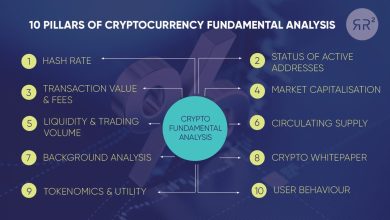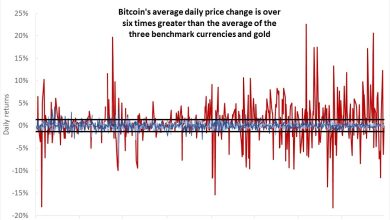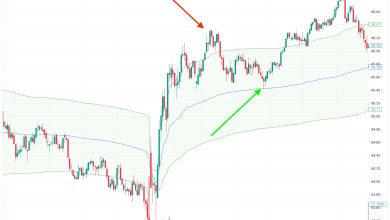Impact of Macroeconomic Events on Crypto Prices

- Understanding the relationship between macroeconomic events and crypto prices
- How government policies influence the volatility of cryptocurrencies
- The role of global economic indicators in shaping the crypto market
- Analyzing the impact of interest rates on the value of digital assets
- Inflation, recession, and their effects on the cryptocurrency landscape
- Case studies: Historical examples of macroeconomic events affecting crypto prices
Understanding the relationship between macroeconomic events and crypto prices
Understanding the relationship between macroeconomic events and cryptocurrency prices is crucial for investors looking to make informed decisions in the volatile market. Various macroeconomic factors can impact the value of cryptocurrencies, leading to fluctuations in prices. By analyzing these events, investors can gain insights into how the market may react and adjust their strategies accordingly.
One key macroeconomic event that can influence cryptocurrency prices is inflation. When fiat currencies experience high inflation rates, investors may turn to cryptocurrencies as a hedge against devaluation. This increased demand can drive up the prices of cryptocurrencies. On the other hand, if inflation is low, investors may be less inclined to invest in cryptocurrencies, leading to a decrease in prices.
Another macroeconomic factor that can affect cryptocurrency prices is geopolitical instability. When there is political turmoil or economic uncertainty in a region, investors may flock to cryptocurrencies as a safe haven asset. This surge in demand can cause prices to rise. Conversely, if geopolitical tensions ease, investors may shift their focus away from cryptocurrencies, resulting in a drop in prices.
How government policies influence the volatility of cryptocurrencies
Government policies play a significant role in influencing the volatility of cryptocurrencies. **Regulations** imposed by governments can have a direct impact on the prices of digital assets. For example, when a government announces stricter regulations on cryptocurrency trading or mining, it can lead to a decrease in demand and subsequently a drop in prices. On the other hand, favorable government policies can boost investor confidence and drive up prices.
Moreover, government actions such as **taxation** policies can also affect the volatility of cryptocurrencies. If a government imposes high taxes on crypto transactions, it can discourage investors and traders, leading to a decrease in trading volume and price fluctuations. Conversely, tax incentives or exemptions can attract more participants to the market, increasing demand and stabilizing prices.
In addition, **monetary** policies implemented by governments can impact the value of cryptocurrencies. For instance, decisions related to interest rates and money supply can influence inflation rates and overall economic stability, which in turn can affect the prices of digital assets. Central banks’ interventions in the economy can create uncertainty among investors, leading to higher volatility in the crypto market.
Overall, government policies play a crucial role in shaping the environment in which cryptocurrencies operate. By closely monitoring and analyzing these policies, investors can better understand the factors driving price fluctuations and make informed decisions regarding their crypto investments.
The role of global economic indicators in shaping the crypto market
The global economic indicators play a crucial role in influencing the cryptocurrency market. These indicators provide valuable insights into the overall health of the global economy, which in turn impacts investor sentiment and risk appetite in the crypto market. Key economic indicators such as GDP growth, inflation rates, unemployment figures, and interest rates can all have a significant impact on the prices of cryptocurrencies.
For example, a strong GDP growth rate may signal a healthy economy, leading to increased investor confidence and a higher demand for cryptocurrencies as an alternative investment. On the other hand, rising inflation rates or unemployment figures may create uncertainty and drive investors towards safer assets, causing a decline in crypto prices.
Interest rates set by central banks also play a crucial role in shaping the crypto market. A hike in interest rates can make traditional investments more attractive compared to cryptocurrencies, leading to a decrease in demand and a subsequent drop in prices. Conversely, a cut in interest rates may boost the appeal of cryptocurrencies as investors seek higher returns in a low-yield environment.
Overall, keeping a close eye on global economic indicators is essential for understanding the dynamics of the crypto market. By analyzing these indicators and their potential impact on investor behavior, traders can make more informed decisions and navigate the volatile crypto market more effectively.
Analyzing the impact of interest rates on the value of digital assets
Interest rates play a crucial role in determining the value of digital assets in the crypto market. When interest rates are low, investors tend to seek higher returns in alternative investments such as cryptocurrencies. This increased demand can drive up the prices of digital assets. Conversely, when interest rates rise, the cost of borrowing increases, leading to a decrease in investment in digital assets as investors seek higher returns elsewhere.
The impact of interest rates on digital assets is not limited to just the direct effect on investor behavior. Changes in interest rates can also affect the overall economy, which in turn influences the value of cryptocurrencies. For example, if interest rates rise due to inflation concerns, it can lead to a decrease in consumer spending and economic growth. This can have a negative impact on the value of digital assets as investors become more risk-averse.
Moreover, central banks play a significant role in setting interest rates, and their monetary policies can have a direct impact on the crypto market. For instance, if a central bank decides to raise interest rates to curb inflation, it can lead to a decrease in the value of digital assets as investors move their funds to traditional assets with higher returns.
In conclusion, interest rates are a key macroeconomic factor that can significantly influence the value of digital assets in the crypto market. Investors need to closely monitor changes in interest rates and understand how they can impact the overall economy and investor sentiment towards cryptocurrencies. By staying informed and adapting to changing market conditions, investors can make more informed decisions when trading digital assets.
Inflation, recession, and their effects on the cryptocurrency landscape
When it comes to the impact of macroeconomic events on cryptocurrency prices, inflation and recession play a significant role in shaping the landscape. Inflation, which refers to the general increase in prices of goods and services, can lead to a decrease in the purchasing power of fiat currencies. This can drive investors towards cryptocurrencies as a hedge against inflation, as many digital assets have a limited supply, making them resistant to inflationary pressures.
On the other hand, recessions, which are characterized by a decline in economic activity, can have a mixed impact on the cryptocurrency market. During times of economic uncertainty, investors may flock to safe-haven assets like gold and cryptocurrencies, driving up their prices. However, recessions can also lead to a decrease in disposable income and risk appetite, causing some investors to liquidate their crypto holdings to cover expenses or reduce risk exposure.
Overall, the effects of inflation and recession on the cryptocurrency landscape are complex and multifaceted. While inflation can drive demand for cryptocurrencies as a store of value, recessions can introduce volatility and uncertainty into the market. It is essential for investors to carefully monitor macroeconomic indicators and market trends to navigate these challenges effectively.
Case studies: Historical examples of macroeconomic events affecting crypto prices
There have been several historical examples of **macroeconomic events** that have had a significant impact on **crypto prices**. These events have demonstrated the interconnectedness between traditional financial markets and the **cryptocurrency** space, highlighting the importance of monitoring **macroeconomic indicators** for **crypto investors**.
- 1. **Global Financial Crisis**: The **global financial crisis** of 2008 had a profound impact on **crypto prices**. As traditional markets plummeted, **investors** sought alternative assets like **cryptocurrencies** as a hedge against economic uncertainty. This led to a surge in **crypto prices**, with **Bitcoin** experiencing a significant rally during this period.
- 2. **Brexit**: The **Brexit** referendum in 2016 also had a notable effect on **crypto prices**. As the **British pound** plummeted in value following the referendum result, **investors** turned to **cryptocurrencies** as a store of value. This resulted in a spike in **crypto prices**, particularly for **Bitcoin** and **Ethereum**.
- 3. **COVID-19 Pandemic**: The **COVID-19 pandemic** in 2020 caused widespread economic turmoil, leading to a sharp decline in **crypto prices** initially. However, as governments around the world implemented massive stimulus packages to support their economies, **investors** once again turned to **cryptocurrencies** as a hedge against inflation. This resulted in a rapid recovery in **crypto prices**, with **Bitcoin** reaching new all-time highs.
These examples demonstrate how **macroeconomic events** can have a profound impact on **crypto prices**, highlighting the need for **investors** to stay informed about global economic developments. By understanding the relationship between **macroeconomics** and **cryptocurrencies**, **investors** can make more informed decisions and navigate the volatile **crypto market** more effectively.





